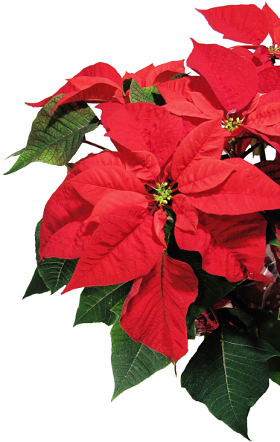 Christmas Traditions »
Christmas Traditions »
The History of Poinsettias
An ornamental shrub, the poinsettia is native to Mexico and Central America, where it was known as Flor de la Noche Buena or "Flower of the Holy Night". It is believed to have been used as a Christmas decoration as early as the 17th century when Franciscan monks near Taxco, Mexico incorporated the plant in their Nativity processions.
According to Mexican legend, a young boy (or young girl named Pepita in some versions) was on his way to visit the village Nativity scene. En route, he realized he had no gift for the Christ child. He gathered pretty green blooms from along the road and brought them to the church. He was ridiculed and mocked by the other children for his humble gift. Yet when laid at the manger, a beautiful, red, star-shaped flower appeared atop the green leaves.
In 1828, Joel R. Poinsett, then U.S. ambassador to Mexico, was introduced to the plant and brought it back with him to America. Poinsett's love of botany led him to cultivate the plant at his home in South Carolina and share specimens of it with friends and botanists.
In the U.S., the plant was later christened the 'poinsettia' in honor of the first American to discover it, and in 1836 Congress declared December 12 National Poinsettia Day to commemorate the death of Joel Poinsett.
The bright red petals, often mistaken for flowers, are actually the upper leaves of the plant called bracts and the tiny flowers are nestled amongst the bracts. Though widely thought to be poisonous to humans, this is actually a myth. According to the POISINDEX, used by most U.S. poison control centers, a 50 lb. child would need to consume more than 500 leaves of the plant to reach a potentially fatal dose of the compounds found in poinsettias. The bitter taste of the plant ensures that most humans and animals rarely take more than one bite.
The poinsettia has become a worldwide holiday favorite for indoor decorating. Though available in a variety of colors – including pink, white, and plum – traditional red is most popular by far. The lovely poinsettia adds a lasting, beautiful splash of color during the Christmas season.
© Deborah Whipp







